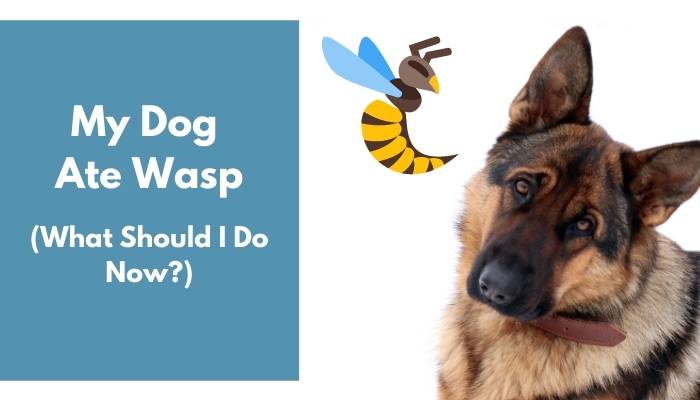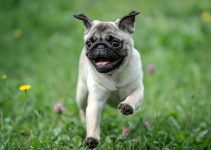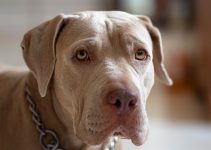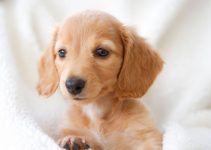Wasps are insects that have quite the sting, but it doesn’t stop a dog from chasing them. Thus, it shouldn’t be a surprise if you see your dog chasing such. Of course, getting stung by a wasp would hurt your pet, but what if it eats such?
So, you may ask: my dog ate wasp: what should I do now? If your dog eats a wasp, the first thing you need is to observe your pet for any reactions the wasp may cause. If your pet exhibits signs or symptoms of health complications, it would be best to take your pet to the vet. This way, your dog will receive proper treatment. Moreover, prevent such an incident from happening in the future.
Dogs have that curious and playful attitude that forces them to deal with things they don’t understand. While it’s a good thing at some point, most instances lead them to danger.
In this article, we’ll tackle everything you need to know about the effects of eating wasps on dogs. This way, you’ll learn how to respond if your dog comes to that instance.
Without further ado, let’s get into it!
Contents
What should I do if my dog ate a wasp?
If your dog ate a wasp, it may or may show any signs of problems or issues. Some dogs would remain healthy and won’t have any problems. Thus, you don’t need to do anything about it.
On the other hand, some dogs may show symptoms that indicate a health complication or issue. In this case, you may need to respond by taking it to the vet and have it checked.
As pet owners, we want to ensure our pets remain safe even if they go overboard playing now and then. Thus, if you see your pet ate a wasp, here are some things you can do.
Observe your dog for symptoms and reactions.
Observe your pet for adverse effects after eating a wasp. This way, you can use it as your hint if your dog needs an expert’s help or if it will be alright without any help at all.
Some dogs may have an adverse reaction towards eating wasps, while others may feel alright. For this reason, it would be best to ensure your pet’s health is okay by checking on it for signs of problems.
Health complications may come to the surface in the next hours or the following days. Thus, it’s ideal for you to continue checking your pet’s health in the next few days.
This way, you can be confident your pet remains alright after eating a wasp.
If your pet shows any signs or symptoms, consult the vet immediately. If, after a few days, your pet seems alright, then you don’t have to do anything further regarding that matter.
Understand what happened.
Understanding what happened is the key to know the proper response and help your dog needs.
For instance, you need to know some information by answering the following questions.
- How long has it been since your pet ate a wasp?
- How many wasps did your pet eat?
- Aside from eating the wasp, was your pet stung by it?
- Aside from wasp, did your pet eat other insects?
As long as you understand what happened, you’ll have all the information to know if your pet needs immediate attention.
Moreover, it will help you understand how grave or how simple the incident was.
Take your dog away from the area.
If your dog continues to loiter in the area, it would be best to keep it inside the house or anywhere far from it. The last thing you’ll want is for your pet to encounter more wasps to eat.
For this reason, it would always be best to secure your pet by taking it inside the house. If it happened inside, put your pet in a room where there are no wasps.
This way, you’ll prevent your pet from accessing more insects. It will also help you examine your pet for any signs or symptoms.
Do something with the wasps around.
The next thing you’ll want to do is prevent the incident from happening again by taking the wasps away.
While it would seem impossible to shoo them away, you can consider taking away what attracts them.
For instance, you may have a garden of flowers or some tree. You can use some wasp repellants to prevent them from sticking around.
Take your pet to the vet.
To ensure your pet’s safety, you can take it to the vet. Or, you can at least have a consultation through a call.
If your pet shows some symptoms or adverse reactions, a physical check-up may be necessary. However, if your pet seems alright, calling your vet would still help.
Through a consultation, you can ensure your pet receives the proper treatment. You will receive recommendations and advice from an expert.
You May Also Read – My Dog Ate Tums: What Should I Do Now?
Can a wasp hurt my dog?
A wasp can hurt a dog if it gets stung by such an insect. The thing about wasps is that they are quite territorial, and they can sting your pet if it gets too playful.
If your dog sees a wasp loitering around, chances are your pet will chase it until it reaches the hive. Other wasps may notice your dog as a threat, and that’s where the real danger lies.
Of course, wasp stings may cause minor pain and irritation issues for your dog.
However, if your pet eats such and the wasp stung its mouth or throat several times, it can cause a severe problem. Such an issue would require an expert’s help.
A wasp sting’s problem is not in the wound it brings. The puncture of a sting is small and would only cause minor pain.
The real problem lies in the small amount of poison it carries. With several strings, it can be a real problem for your pet.

Can a dog die from eating a wasp?
It’s quite rare and unheard of that eating wasps are the cause of a dog’s death. However, it’s not entirely impossible.
The thing is that eating a wasp won’t give your dog any severe symptoms. Now, it’s an entirely different thing if your pet already suffers from grave danger.
While the incident may not cause your pet’s death, it may be a factor for your dog’s illness to worsen.
Many people think that wasps are poisonous, and they can cause a dog’s death if eaten.
If your dog is healthy when it eats a wasp, it won’t die just by that incident.
Can a wasp sting kill a small dog?
It’s also unusual for a wasp’s sting to kill a dog. However, it’s also not entirely impossible.
For instance, a small dog that receives too many stings from wasps can be lethal.
If your pet is a small dog and eats a live wasp, that insect may sting your dog’s mouth and throat.
Such a sting can cause severe symptoms. Among these are difficulty breathing, weakness, skin redness, swelling, etc.
Another thing that can cause an issue is that if your small dog already has other health problems.
The sting and the small amount of poison in it may cause the former health complication to deteriorate.
For this reason, preventing such incidents is critical for every pet owner.
My dog ate a dead wasp – what to do?
Unlike a live one, a dead wasp is less likely to cause your pet an issue. The reason is that you won’t have to worry about a possible wasp sting.
Still, it doesn’t mean you won’t have to worry about anything at all.
The first thing you need to do is to observe your pet for reactions after eating the wasp.
In general, eating a live wasp and a dead one would produce the same effects. The only difference is that a live one may sting your pet’s throat or mouth before it gets ingested.
The reason why observation is important is that it will help you figure out what to do next.
If your pet shows any signs of complications or issues, it would be best to consult your vet.
However, if your pet shows no problem, it would be alright to leave it as it is. Still, make sure you prevent such an incident from happening again in the future.
You May Also Read – My Dog Ate Bee: What Should I Do Now?
Dog ate wasp larvae – what to do?
Wasp larvae are safe for dogs to eat. Thus, it shouldn’t cause any issue if you see your pet ate such.
Of course, it would be an entirely different thing your pet ingested many larvae. However, a piece or two shouldn’t be enough for you to worry about in this case.
Still, the first thing to do is observe your pet if it shows signs or symptoms of a health problem after eating.
Your pet may exhibit symptoms like vomiting, difficulty breathing, redness, and other signs. If such happens, contact your vet immediately.
How to prevent dogs from eating wasps?
While a dog-eating-wasp incident isn’t new, it should be a lesson to prevent it from happening again.
Here are some of the things you can do to prevent your pet from eating wasps again.
Do something with your flowers.
The primary reason why wasps would hang out in your area would be flowers or any vegetation.
It may not be ideal for you to take away all your flowers and vegetation. However, it’s something to consider, especially if your pet gets stung all the time.
Another thing you can do is prevent your pet from playing nearby. Or, only allow such if your pet is under your supervision.
If you can’t remove your flowers, you can mix up some plants that can repel wasps. Among these are mint, cucumber, and marigold.
Spray some non-toxic wasp repellent.
Non-toxic wasp repellents exist, and they are available in markets today. If you didn’t remove your flowers, it would be best to keep wasps away by spraying some repellant.
However, as you do this, make sure it’s safe for your dog, in case it will play around in your area.
By removing the wasps, you’ll lessen your dog’s urge to play around with them.
As always, the use of such repellants should be with your vet’s approval. This way, you can ensure your pet’s safety.
Divert your dog’s attention.
Another thing you can do is to divert your dog’s attention away from the wasps. You can do this by giving your pet an interactive toy.
Moreover, it would be best to allow your pet to stay indoors if you can’t play with it.
This way, you’ll avoid having your pet running around and chasing wasps again.
Introduce such toys with your guidance, and leave them with your pet only as long as you think it’s alright. It may take a few days or weeks, depending on the output of your dog.
What should you do if your dog ate ant traps or charcoal? Learn more about it!
Summary
Wasps aren’t a nuisance and a danger as long as you don’t provoke them. However, with dogs, leaving them alone isn’t quite an option. For this reason, it’s not surprising if you see your pet eating such or getting stung by it.
As always, the first thing you need is to observe your pet for signs of reactions after eating. It will lead you to know what to do next. If your pet seems alright even after a few days, you don’t need to do anything.
However, if your pet would show severe symptoms, it would be best to contact a vet right away. This way, your pet will receive the proper treatment, and you’ll keep it safe.
Of course, the next thing you need to do is to prevent that incident from happening again. As long as you do so, you can be confident your pet won’t get stung by a wasp again.
Resources
Image credits – Canva



